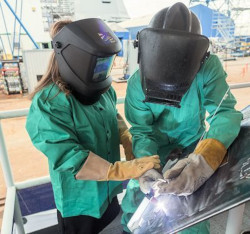Non-Ionizing Radiation
Non-ionizing radiation is composed of oscillating electric and magnetic fields found in a wide range of occupational settings.
These fields can pose a considerable health risk to exposed workers if not properly controlled. Non-ionizing radiation includes each of the following:
- Extremely Low Frequency Radiation (ELF): Extremely Low Frequency (ELF) radiation at 60 Hz is produced by power lines, electrical wiring, and electrical equipment.
- Radiofrequency (RF) and Microwave Radiation (MW): Microwave radiation is absorbed near the skin, while RF radiation may be absorbed throughout the body. At high enough intensities, both will damage tissue through heating.
- Infrared Radiation (IR): The skin and eyes absorb infrared radiation (IR) as heat. Workers normally notice excessive exposure through heat sensation and pain. Sources of IR radiation include furnaces, heat lamps, and IR lasers.
- Visible Light Radiation: The different visible frequencies of the electromagnetic (EM) spectrum are "seen" by our eyes as different colors. Good lighting is conducive to increased production and may help prevent incidents related to poor lighting conditions. Excessive visible radiation can damage the eyes and skin.
- Ultraviolet Radiation (UV): Ultraviolet radiation (UV) has a high photon energy range and is particularly hazardous because there are usually no immediate symptoms of excessive exposure. Sources of UV radiation include the sun, black lights, welding arcs, and UV lasers.
- Laser Hazards: Lasers typically emit optical (UV, visible light, IR) radiations and are primarily an eye and skin hazard. Common lasers include CO2 IR laser, helium-neon, neodymium YAG, and ruby visible lasers, and the Nitrogen UV laser.
General safety precautions while using lasers include:
- Wear appropriate protective eyewear.
- Use minimum power/energy required for the project.
- Reduce laser output with shutters/attenuators.
- Terminate laser beam with beam trap.
- Use diffusing reflective screens, remote viewing systems, etc., during alignments.
- Remove unnecessary objects from the vicinity of the laser.
- Keep the beam path away from eye level (sitting or standing).
- Don't put your body parts (especially the eyes) in the beam.
Knowledge Check Choose the best answer for the question.
5-4. Which of the following is non-ionizing radiation?
You forgot to answer the question!


